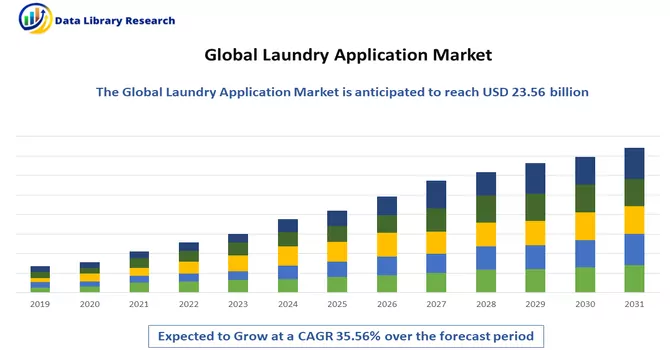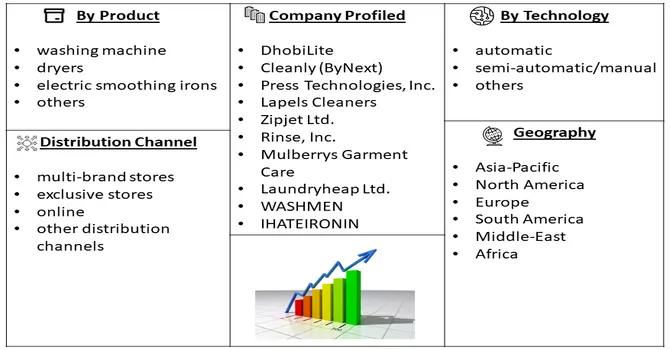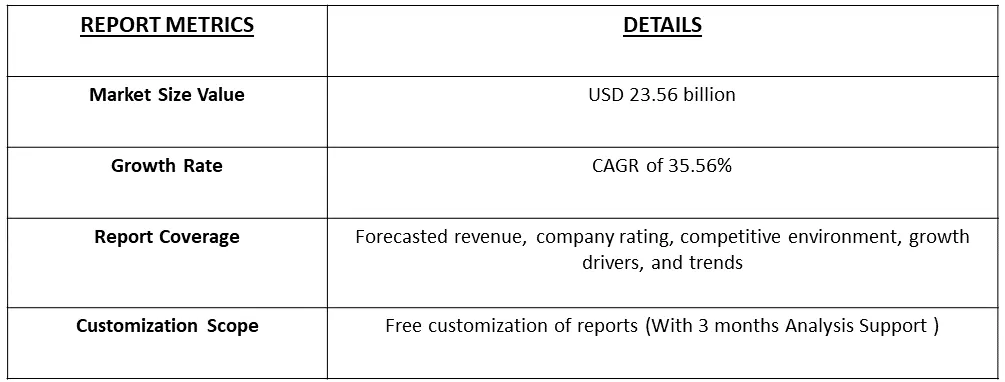In 2022, the global market for online laundry services reached a valuation of USD 23.56 billion and is anticipated to exhibit substantial growth at a compound annual growth rate (CAGR) of 35.56% throughout the forecast period from 2023 to 2030.

Get Complete Analysis Of The Report - Download Free Sample PDF
The laundry application market encompasses software solutions designed to streamline and enhance various facets of laundry operations, including management, scheduling, billing, and customer interactions. These applications find utility among laundry businesses, laundromats, dry cleaners, and similar establishments with the aim of boosting efficiency and elevating customer experience. By automating and optimizing diverse processes, laundry applications contribute to a reduction in manual efforts, minimize errors, and enhance overall operational efficiency. Noteworthy features such as automated scheduling, inventory management, and billing systems serve to save time for owners and employees of laundry businesses, enabling them to divert their attention to other crucial aspects of operations. Moreover, applications facilitating customer-centric functionalities like online scheduling of pickups, order tracking, and digital payments offer unparalleled convenience, thereby elevating the overall customer experience.
The integration of communication tools within these applications further facilitates improved interactions between businesses and customers, cultivating stronger relationships and fostering loyalty in the competitive landscape.
Laundry applications are increasingly embracing mobile-friendly interfaces and integrating seamlessly with mobile apps. These user-friendly apps empower customers to conveniently schedule pickups, track orders, and make payments directly from their smartphones. A notable trend in the market is the emergence of on-demand laundry services, facilitated by applications that enable users to request laundry services at their preferred time and location, emphasizing convenience and flexibility. The integration of Internet of Things (IoT) technology into laundry applications takes connectivity to the next level by linking with smart machines and devices. This connectivity allows for remote monitoring, machine diagnostics, and predictive maintenance, ultimately optimizing operational efficiency in the laundry process. Moreover, laundry applications are capitalizing on automation and artificial intelligence (AI) to handle tasks such as scheduling, route optimization, and inventory management. This not only reduces manual intervention but also enhances accuracy in these crucial operational aspects.
Market Segmentation: The Laundry Appliances Market report is segmented by product (washing machine, dryers, electric smoothing irons, others), by technology (automatic, semi-automatic/manual, and others), by distribution channel (multi-brand stores, exclusive stores, online, and other distribution channels), by geography (North America, Latin America, Asia-Pacific, Europe, and the Middle East And Africa).

For Detailed Market Segmentation - Download Free Sample PDF
Market Drivers :
Technological Advancements and Smart Appliances
The landscape of laundry appliances has been reshaped by technological advancements, ushering in the era of smart washing machines and dryers equipped with cutting-edge features. These appliances go beyond traditional functionalities, incorporating innovations such as Wi-Fi connectivity, app-based controls, and sensors that optimize key parameters like water usage, detergent dosage, and cycle times. The emphasis in modern laundry appliances is on energy efficiency and sustainability, incorporating technologies like inverter motors, heat pump dryers, and eco-friendly washing cycles. The integration of Wi-Fi connectivity and app-based controls allows users to remotely operate and monitor their laundry appliances, adding a layer of convenience to the user experience. Moreover, sensors embedded in these appliances enable intelligent optimization of resource usage, contributing to both cost savings for users and a reduction in environmental impact.
In line with the growing demand for eco-friendly solutions, these technological advancements cater to environmentally-conscious consumers. Features like inverter motors enhance energy efficiency, while innovations such as heat pump dryers and eco-friendly washing cycles further align with sustainability goals. This trend is exemplified by the expansion of Rinse, Inc. in February 2023, as the company extended its services to Dallas and Austin, Texas. The move garnered a significant response, with Rinse, Inc. offering a USD 50 credit for new users signing up. Thus, the convergence of technological innovations in laundry appliances not only enhances user convenience but also addresses the increasing demand for energy-efficient and eco-friendly solutions, contributing to the anticipated growth of the market over the forecast period.
Changing Consumer Lifestyles and Urbanization
As urbanization progresses and lifestyles become busier, there's a growing demand for laundry appliances that offer time-saving features. Consumers seek appliances with quick wash cycles, larger capacities, and efficient performance to accommodate their fast-paced lives. The rising number of households, especially in urban areas, drives the demand for laundry appliances. As more people move into homes and apartments equipped with laundry spaces, there's a higher propensity to invest in washing machines and dryers, boosting market growth. For instance, an article published by NCBI in July 2021, repored that by 2050 about 64% of the developing world and 86% of the developed world will be urbanized. Thus, such instances are driving the studied market growth.
Market Restraints:
The landscape of laundry appliances has undergone a significant evolution due to technological advancements, giving rise to smart washing machines and dryers equipped with advanced features. These appliances boast enhanced functionalities, including features such as Wi-Fi connectivity, app-based controls, and sensors designed to optimize crucial elements such as water usage, detergent dosage, and cycle times. Contemporary laundry appliances are designed with a strong emphasis on energy efficiency and sustainability. Key technologies, such as inverter motors, heat pump dryers, and eco-friendly washing cycles, not only contribute to a reduction in energy consumption but also cater to the preferences of environmentally-conscious consumers actively seeking eco-friendly options. Moreover, the incorporation of Wi-Fi connectivity and app-based controls adds a layer of convenience, enabling users to operate and monitor their laundry appliances remotely. Meanwhile, the embedded sensors play a pivotal role in intelligently optimizing resource usage, translating into cost savings for users and a decreased environmental impact.
Thus, the convergence of technological advancements in laundry appliances not only elevates user convenience but also addresses the increasing demand for energy-efficient and eco-friendly solutions. This trend is anticipated to contribute substantially to the growth of the market in the foreseeable future.
In the initial phases of the pandemic, movement restrictions, lockdowns, and disruptions in global supply chains posed significant challenges in procuring components and raw materials. These difficulties in sourcing directly impacted the manufacturing capabilities of the laundry appliance industry, resulting in notable delays in both production and distribution processes. A considerable number of manufacturing facilities had to temporarily close or operate at reduced capacities due to health and safety concerns for their workforce. These precautionary measures had a cascading effect on the overall output of laundry appliances, further compounding the challenges faced by the industry during a time of unprecedented global uncertainty.
Segmentation Analysis:
Washing Machine Segment is Expected to Witness Significant growth Over the Forecast Period
Washing machines are commonly divided into two main types: top-loading and front-loading machines. Each category comes with its own set of advantages. Top-loading machines are generally appreciated for their convenience in terms of loading and unloading clothes. On the other hand, front-loading machines are often recognized for their superior energy and water efficiency. High-efficiency washers, encompassing both top-loading and front-loading models, have been engineered to consume less water and energy compared to traditional machines. This particular design appeals strongly to consumers who prioritize environmental consciousness. The emphasis on reduced resource consumption aligns with the preferences of individuals seeking sustainable and eco-friendly choices in their household appliances. Thus owing to above-mentioned advantages, the segment is expected to witness significant growth over the forecast period.
Automatic Technology Segment is Expected to Witness Significant growth Over the Forecast Period
Automatic technology has revolutionized the laundry industry, offering a seamless and efficient approach to managing laundry tasks. This technology has been integrated into various aspects of laundry appliances and systems, providing users with enhanced convenience and performance. Modern washing machines feature smart controls that allow users to customize settings, select wash cycles, and monitor progress through user-friendly interfaces or mobile apps. Washing machines often incorporate sensors to optimize water usage, detergent dispensing, and cycle durations, ensuring efficient cleaning while minimizing resource consumption. Automatic laundry appliances can include auto-dosing systems that precisely dispense the required amount of detergent for each load. This not only ensures optimal cleaning but also minimizes wastage.
Moreover, automatic laundry technology can be part of broader smart home ecosystems, enabling integration with other devices. For example, users may receive notifications when a laundry cycle is complete or when it's time to replenish detergent. Thus, owing to above-mentioned advantages automatic technology in laundry not only simplifies daily chores but also contributes to resource efficiency, time savings, and an overall enhanced user experience, as a result the segment is expected to witness significant growth over the forecast period.
North America Region is Expected to Witness Significant growth Over the Forecast Period
Consumers in North America prioritize innovative features when it comes to their choices in laundry appliances. They have a strong preference for washing machines and dryers that come equipped with smart technology, energy-efficient attributes, and convenient features like Wi-Fi connectivity, app-based controls, and advanced settings. Energy efficiency is a key consideration, with consumers actively seeking appliances, particularly washing machines, that bear Energy Star ratings and align with established environmental standards. These factors play a pivotal role in shaping consumer purchasing decisions.
Furthermore, recent developments are poised to contribute significantly to the growth of the market in the region during the forecast period. An illustrative example is the announcement in February 2023, where a franchise owner of Lapels Cleaners revealed plans to inaugurate a new store, Lapels Cleaners of Indian Land, in South Carolina in April of the same year. This strategic expansion demonstrates the commitment to regional growth and underscores the dynamic developments shaping the laundry appliance market in North America.

Get Complete Analysis Of The Report - Download Free Sample PDF
The report encompasses prominent international players actively participating in the Laundry Appliances Market. Currently, a few major players hold significant market share. Nevertheless, the landscape is evolving with technological advancements and product innovations, allowing mid-sized to smaller companies to expand their market footprint. These companies are achieving this by securing new contracts and exploring untapped markets. The dynamic nature of the industry suggests a shift in market dynamics as smaller players leverage advancements to enhance their presence. Some of the key players operating in the global online laundry service market include:
Recent Developments:
1) September 2023: LG Electronics introduced the Signature Washer-Dryer, the fusion of a large-capacity drum washing machine and an inverter heat pump dryer. This single product handles both washing and drying. It has a washing capacity of 25 kg and a drying capacity of 13 kg, with a 4 kg mini-wash feature at the bottom.
2) August 2023: Thomson launched its new range of semi-automatic top-load washing machines in India. The latest lineup includes six new models with 7kg, 7.5 Kg, 8 kg, and 8.5kg capacities. These washing machines that start at Rs 7,590 and go up to Rs 9,999 have been manufactured in India
Q1. What was the Laundry Application Market size in 2022?
As per Data Library Research the global market for online laundry services reached a valuation of USD 23.56 billion in 2022
Q2. What is the Growth Rate of the Laundry Application Market ?
Laundry Application Market is anticipated to exhibit substantial growth at a compound annual growth rate (CAGR) of 35.56% over the forecast period.
Q3. What are the factors on which the Laundry Application market research is based on?
By Product, By Application, By Distribution Channel and Geography are the factors on which the Laundry Application market research is based.
Q4. What are the factors driving the Laundry Application market?
Key factors that are driving the growth include the Technological Advancements and Smart Appliances and Changing Consumer Lifestyles and Urbanization
Data Library Research are conducted by industry experts who offer insight on industry structure, market segmentations technology assessment and competitive landscape (CL), and penetration, as well as on emerging trends. Their analysis is based on primary interviews (~ 80%) and secondary research (~ 20%) as well as years of professional expertise in their respective industries. Adding to this, by analysing historical trends and current market positions, our analysts predict where the market will be headed for the next five years. Furthermore, the varying trends of segment & categories geographically presented are also studied and the estimated based on the primary & secondary research.
In this particular report from the supply side Data Library Research has conducted primary surveys (interviews) with the key level executives (VP, CEO’s, Marketing Director, Business Development Manager and SOFT) of the companies that active & prominent as well as the midsized organization
FIGURE 1: DLR RESEARH PROCESS

Extensive primary research was conducted to gain a deeper insight of the market and industry performance. The analysis is based on both primary and secondary research as well as years of professional expertise in the respective industries.
In addition to analysing current and historical trends, our analysts predict where the market is headed over the next five years.
It varies by segment for these categories geographically presented in the list of market tables. Speaking about this particular report we have conducted primary surveys (interviews) with the key level executives (VP, CEO’s, Marketing Director, Business Development Manager and many more) of the major players active in the market.
Secondary ResearchSecondary research was mainly used to collect and identify information useful for the extensive, technical, market-oriented, and Friend’s study of the Global Extra Neutral Alcohol. It was also used to obtain key information about major players, market classification and segmentation according to the industry trends, geographical markets, and developments related to the market and technology perspectives. For this study, analysts have gathered information from various credible sources, such as annual reports, sec filings, journals, white papers, SOFT presentations, and company web sites.
Market Size EstimationBoth, top-down and bottom-up approaches were used to estimate and validate the size of the Global market and to estimate the size of various other dependent submarkets in the overall Extra Neutral Alcohol. The key players in the market were identified through secondary research and their market contributions in the respective geographies were determined through primary and secondary research.
Forecast Model
